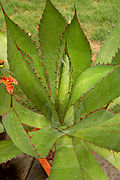
Agave americana, commonly known as the century plant, maguey, or American aloe, is a flowering plant species belonging to the family Asparagaceae. It is native to Mexico and the United States, specifically Texas. This plant is widely cultivated worldwide for its ornamental value and has become naturalized in various regions, including Southern California, the West Indies, South America, the Mediterranean Basin, Africa, the Canary Islands, India, China, Thailand, and Australia.

Agave vilmoriniana, sometimes misspelled vilmoriana, and popularly known as octopus agave, is a species of agave endemic to México. It is known for its untoothed arching and twisting leaves.

Agave attenuata is a species of flowering plant in the family Asparagaceae, commonly known as the foxtail or lion's tail. The name swan's neck agave refers to its development of a curved inflorescence, unusual among agaves. Native to the plateaux of central west Mexico, as one of the unarmed agaves, it is popular as an ornamental plant in gardens in many other places with subtropical and warm climates.

Agave bracteosa is a species of agave sometimes known as spider agave or squid agave. It is native to the Sierra Madre Oriental of México, where it prefers well-drained and shaded or semi-protected locations on cliffs and rocky slopes from 900 to 1,700 meters. Although it occupies a small range, it is not considered to be threatened.

Agave chiapensis is a species of Agave native to the Mexican states of Chiapas and Oaxaca. It has also been reported from Costa Rica and Guatemala. Populations of this species are relatively small and isolated, and are threatened by urban and agricultural expansion, particularly in Chiapas.

Agave victoriae-reginae, the Queen Victoria agave or royal agave, is a small species of succulent flowering perennial plant, noted for its streaks of white on sculptured geometrical leaves, and popular as an ornamental.

Agave lechuguilla is an Agave species found only in the Chihuahuan Desert. The plant flowers once in its life and then dies.

Beaucarnea recurvata, the elephant's foot or ponytail palm, is a species of plant in the family Asparagaceae. The species was native to numerous states of eastern Mexico but is now confined to the state of Veracruz. Despite its common name, it is not closely related to the true palms (Arecaceae). It has become popular in Europe and worldwide as an ornamental plant. There are 350-year-old Beaucarneas registered in Mexico.

Agave mitis is a plant species native to the Mexican states of Hidalgo, Tamaulipas and San Luis Potosí, referred to as Agave celsii in many publications.

Agave salmiana is a species of the family Asparagaceae, native to central and southern Mexico. It is also reportedly naturalized in South Africa, Italy and Spain, specially in the Canary Islands.
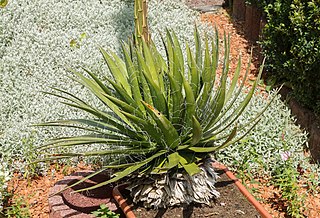
Agave filifera, the thread agave, is a species of flowering plant in the family Asparagaceae, native to Central Mexico from Querétaro to Mexico State. It is a small or medium-sized succulent plant that forms stemless rosette up to 3 feet (91 cm) across and up to 2 feet (61 cm) tall. The leaves are dark green to a bronzish-green in color and have very ornamental white bud imprints. The flower stalk is up to 11.5 feet (3.5 m) tall and is densely loaded with yellowish-green to dark purple flowers up to 2 inches (5.1 cm) long. Flowers appear in autumn and winter.
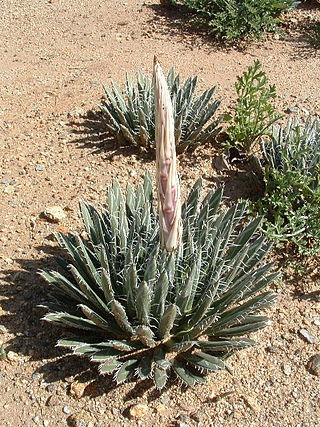
Agave polianthiflora is a relatively small member of the genus Agave, in the subfamily Agavoideae, endemic to northern Mexico.

Agave xylonacantha is a plant species native to Hidalgo, Tamaulipas, Guanajuato and Queretaro in Mexico, but commonly cultivated as an ornamental on other regions. A. xylonacantha is an easy-to-grow member of the genus Agave. The specific epithet 'xylonacantha' means "wood spines".

Agave shrevei is a member of the family Asparagaceae, indigenous to the Sierra Madre Occidental in Mexico, along the boundary between the states of Chihuahua and Sonora. Two subspecies are currently recognized, although a third has been proposed.

Agave striata is a plant species native to Northeastern Mexico. Because the species is widespread and does not appear to be under any significant threats, it is not considered by the IUCN to be threatened.

Yucca madrensisH. S. Gentry is a plant in the genus Yucca in the family Asparagaceae. It is native to a mountainous region in the Sierra Madre Occidental in the Mexican states of Sonora and Chihuahua. It has also been reported from Arizona It grows on steep, rocky slopes in pine-oak forests.

Yucca grandifloraGentry is a plant in the family Asparagaceae, native to the Sierra Madre Occidental in the Mexican states of Chihuahua and Sonora.
Agave univittata, the thorn-crested century plant or thorn-crested agave, is a plant species native to coastal areas of southern Texas and northeastern Mexico, at elevations less than 100 m. It has been widely named Agave lophantha by botanists including Howard Scott Gentry, but the name A. univittata is older and therefore more in accord with nomenclatural rules of botany.
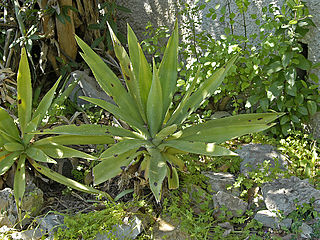
Agave decipiens, common names false Sisal or Florida agave, is a plant species endemic to coastal Florida in the United States.
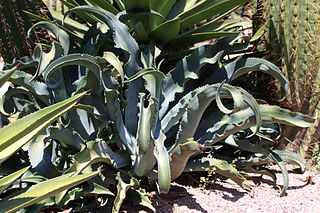
Agave gypsophila is a species of plant in the Asparagaceae family and is endemic to the Mexican state of Guerrero. The specific epithet, gypsophila, means gypsum loving.


